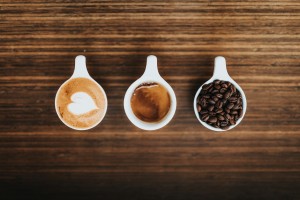Many people explain and label their roasted coffees in various ways. But what do the terms and the magical dots, beans, or stars on the packaging actually mean? Commercial coffee varieties lead the way in obfuscation. Let's get this – coffee - straight: What does "strong" mean to each of us?
Does strong mean bitter? Perhaps darker? Thicker? Hotter? Does it wake you up more? And how can I determine that after the first sip?
The truth is that a professionally made espresso contains just as much caffeine a a lungo, or long coffee. A café lungo is a double-diluted coffee, meaning 60 ml of water is used for 8 grams of coffee, unlike an espresso, which contains 30 ml of water. To call the coffee a café lungo, we need to dilute it with hot water in a 1:1 ratio.
So, should we avoid talking about "stronger" coffee altogether? Maybe it's worth avoiding this term. There are indeed differences in caffeine content depending on the coffee's growing region, roast, and variety, but we won't notice this in the first sip.
We prefer to put it more cautiously:

Intensity:
The intensity of flavors is influenced by several factors: both the roasting level and method, the body of the coffee, its variety, and its growing region can make the final taste experience stronger or milder. Body includes the texture of the coffee and the mouthfeel. This concept provides an idea of the density, viscosity, and whether a coffee can create a sensation on our lips and whether it envelops our mouth with a long, creamy feeling or has a fresh, thin, flowing finish when consumed.
Roasting:
During roasting, coffee beans undergo physical and chemical changes. They lose moisture content, their carbohydrates content turns into sugar and then caramelize, and its caffeine content is released.
Traditionally, we distinguish four levels of coffee roasting. The longer we roast the coffee beans, the more intense the color becomes. It becomes fruitily sweet, then turns bitter. Its acidity decreases. Its body becomes fuller. The sequence includes Hamburg, Viennese, French, and Italian roasting.
We think in much more levels than this. Our roastmaster works in a gradation-free mode.
Acidity:
Acidity is the primary taste sensation in coffee, which we perceive as a pleasant and exciting freshness at the front of the mouth, a tingling on the tip of the tongue, or dryness at the back of the palate and/or under the sides of the tongue.
Coffee is naturally an acidic beverage. The level of acidity can vary depending on the type of coffee bean and the brewing method. But acidity is not necessarily a bad thing. In fact, it is one of the qualities that makes coffee taste so good.
If we look at the chart of different coffee roasting levels, it is evident that the darker the roast, the lower the level of chlorogenic acid. This is why the currently popular light-roasted coffees are more acidic - in other words, full of flavors. Think of it in terms of wine gastronomy.
Even the often underrated robusta coffee is rich in acids. That's why it's worth playfully mixing arabica and robusta varieties.
Caffeine:
It's good to know what kind of stimulating effect to expect. Two main rules of thumb apply here: the Arabica coffee variety contains significantly less caffeine than Robusta (about half the amount). Darker roasted coffee (by volume) loses some of its caffeine content.
And finally, the subjective overall score: the Pas-o-meter
Our six-member product development team has objectively considered the above criteria and rated our coffees with an overall score . The two ends of the scale are not meant to represent the strength, acidity, or quality of the coffee. Rather, it aims to convey the consumption experience by placing the indicator between two extremes: the "café" and the "specialty" coffee experience. The further left the pointer leans, the more we get a café experience: high-quality hot black coffee, enticing aromas, sunshine. On the right, we find all the adventures of specialty coffee: a symphony of flavors, bold acidity, and lots of laughter. Which one you choose is up to you. You can't be in two places at once...but who said you can only have one coffee a day?!





